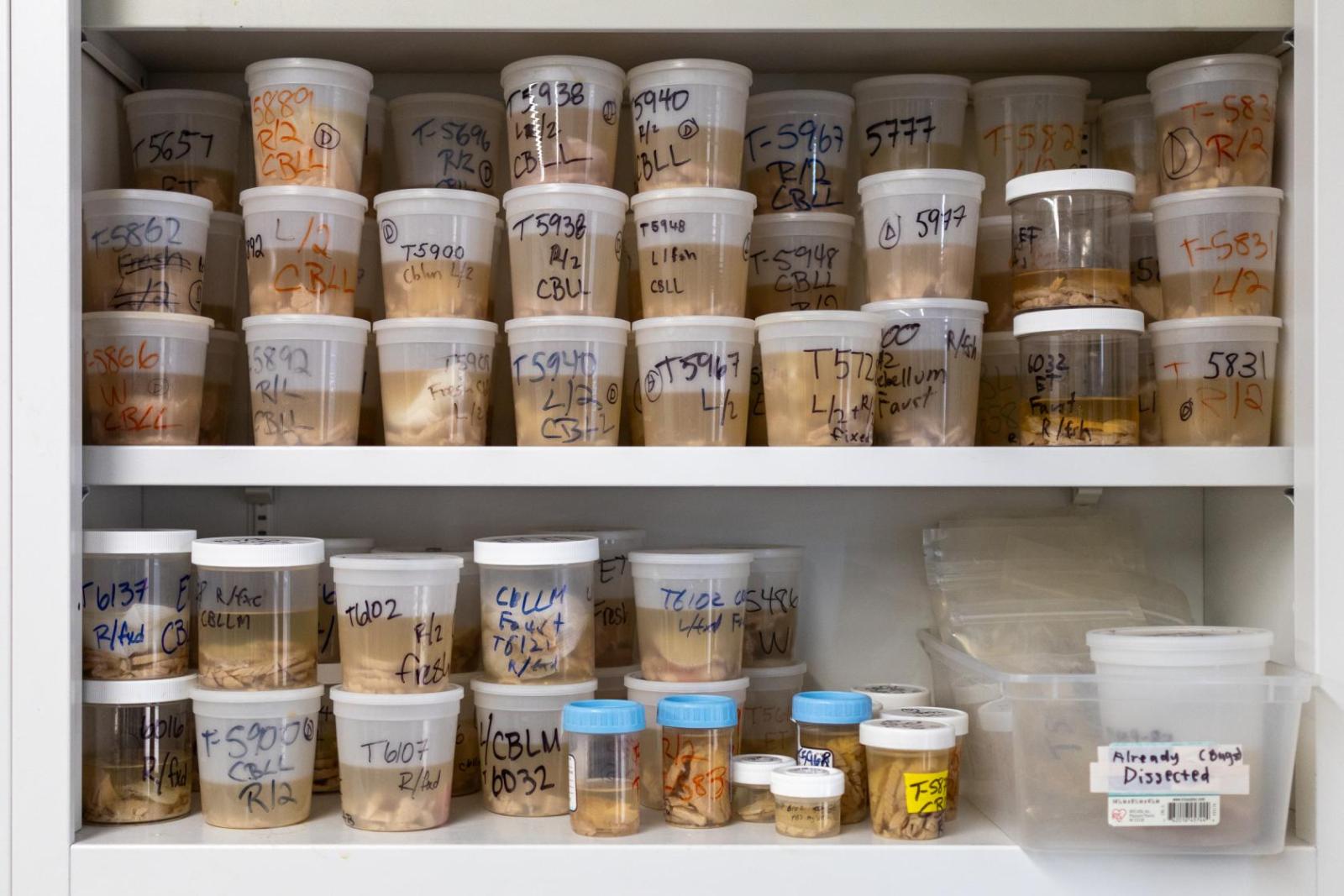Well into Katharine Hepburn's film career, moviegoers noticed a warble in her voice and a quaking of her head and hands. In the 70s and 80s, many speculated that she had Parkinson's disease, but years later it was revealed that the Oscar-winning actress had essential tremor, a progressive neurological disorder that causes involuntary, rhythmic trembling of the hands, head, and/or other body parts.
When Hepburn died in 2003 (of heart disease), nothing was known about the underlying biology of essential tremor. The disorder is far more common than Parkinson's but isn't life-threatening, and symptoms typically worsen with age, interfering with everyday tasks. The lack of knowledge about essential tremor impeded efforts to devise effective diagnostics and therapeutics.
"Back then, the accepted wisdom was that there were no structural changes in the brains of people with essential tremor," says Phyllis Faust, a neuropathologist at the Columbia University Vagelos College of Physicians and Surgeons and a pioneer in the study of the disorder's biology. "But those conclusions were made from examinations of a very small number of brain specimens."
That would soon change. The same year that Hepburn died, Columbia neurologists created the first-ever "brain bank" for essential tremor. "The study of human tissue is currently the most direct method to gain a mechanistic insight into the pathogenesis of this disease," says Faust, who has been working with the repository since 2006.

Essential tremor neurons. Samples from the Essential Tremor Centralized Brain Repository are helping scientists uncover the roots of the disease. In the photo, Columbia neuropathologist Phyllis Faust examines Purkinje cells from a patient; abnormalities in and around the brain's Purkinje cells are now known to be common in people with essential tremor. Photo: Columbia University Irving Medical Center.
As the bank's scientists had hoped, the Essential Tremor Centralized Brain Repository jumpstarted research into the disorder, which is estimated to affect more than 7 million people in the United States. Within a few years, researchers affiliated with the repository discovered that essential tremor might arise in the cerebellum, the small structure at the back of the brain that controls muscle movement, among other functions. Soon after, the researchers identified various types of abnormalities in and around Purkinje cells (the largest cerebellar neurons) in the brains of people who had had the disease.
To date, the repository (based at the New York Brain Bank at Columbia) has amassed more than 250 brains from essential tremor patients, by far the largest collection of its kind worldwide.
Collecting and preparing brains for the repository is costly and starts well before the patient's natural death. The process begins when a patient with essential tremor enrolls in a study to follow the patient's clinical course and consents to donate his or her brain for research. Specialized diagnosticians are then dispatched to evaluate the prospective donor to confirm the diagnosis (there are no blood or imaging tests) and organize in advance a detailed brain procurement plan.
"It is critical to do this planning ahead of time as this enables rapid procurement of the brain within hours of the patient's death," Faust says, "which gives us the tissue quality needed for the studies we perform." The process is labor intensive, but patients and their families are highly committed to help researchers understand the disease and develop potential therapies. "Very few have withdrawn from the study," adds Faust.

Brain tissue samples for essential tremor research in the Faust laboratory. Photo: Columbia University Irving Medical Center.
Faust recently used repository specimens to devise a way to diagnose essential tremor after death, based on 11 degenerative changes seen in Purkinje cells. At present, the disease can be diagnosed only by clinical findings-as much an art as a science. As a result, one-third to one-half of cases are misdiagnosed, according to some estimates. "Our tool has an accuracy rate of more than 90%," says Faust, who co-led the study with Elan Louis, chair of neurology at University of Texas Southwestern Medical Center. (Louis helped launch the Essential Tremor Centralized Brain Repository when he was a professor of neurology at Columbia).
An accurate postmortem diagnostic tool won't help these patients, of course, but it could inform the care of their parents, siblings, or children, who are five times more likely to develop the disease than the general population. In addition, Faust says, it is an important step to allow confirmation of clinical diagnoses, which has been a hallmark of research in other neurodegenerative diseases. The findings could hasten the development of molecular biomarkers and neuroimaging tests for diagnosing essential tremor in living patients, reducing misdiagnoses and improving treatments for the disease.
Faust's current studies are casting a wider net in the search for causes of essential tremor. "We've sampled just one region of the cerebellum, but this organ is quite heterogeneous. It's likely that other parts are involved," she says. For instance, the researchers are studying whether essential tremor affects the portion of the cerebellum involved in cognition, which could explain why some people with tremors also experience anxiety, depression, and increased risk of dementia.
Her team is also looking at whether there are pathological changes elsewhere in a "tremor circuit" in which other brain structures, such as the thalamus, motor cortex, and inferior olive, contribute to the propagation of tremors.
"Our studies have only grazed the surface of this disease," says Faust.
References
Additional information
Phyllis Faust, MD, PhD, is professor of pathology & cell biology at Columbia University Vagelos College of Physicians and Surgeons and a neuropathologist at NewYork-Presbyterian Hospital.
For her work on postmortem diagnosis, Faust received the Hirano Award for the Best Clinico-Pathologic Paper in Neurodegeneration at the 2024 American Association of Neuropathologists annual meeting.






